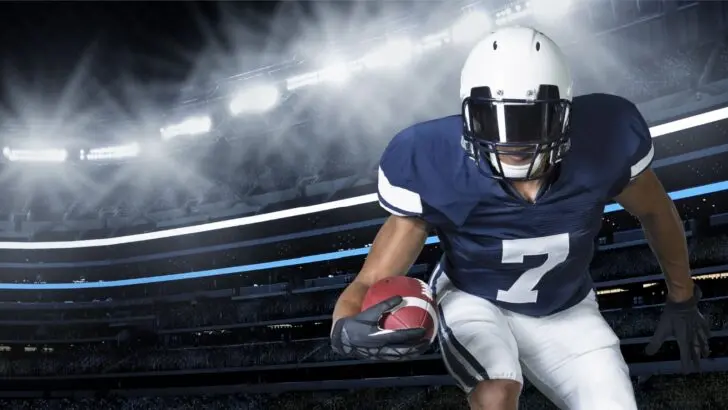The National Football League is, by far, the most popular sports league in the United States. In fact, in the United States, nearly two-fifths of all Americans have indicated that they are at least somewhat interested in the league and the weekly games.
With the fast-paced nature, gladiator style of play, and limited number of games in a season, the NFL has monopolized sports viewership on any given Sunday.
But, for both avid and casual fans of the sport, determining both the length of an average NFL game and just how much time the football is in play, can be difficult. That’s why, below, we are going to review both how long an NFL game is and just how many minutes of actual gameplay occur.
How Many Quarters Are in an NFL Game?
The NFL, similar to the NBA, is broken down into four separate quarters. However, unlike the NBA’s 12-minute quarters, the NFL is composed of 15-minute quarters, with a halftime break between the second and third quarter.
Being that there are four overall 15-minute quarters in an NFL game, the total time allotted for an NFL game is just 60-minutes.
The halftime break in the NFL is composed of 12-minutes and allows for players, coaches, and coaching staff to regroup and strategize on plays and both offensive and defensive formations which are currently working and which ones need to be reworked for the current game.
In addition to strategizing, the halftime break offers players a much needed break to the gameplay. With football being one of the most rigorous, stressful, and rough sports, a halftime break allows players to regroup and re-energize before the start of the second half of the game.
What Do Fans Do During The Halftime Break?
Depending on whether you are at the game or watching from the comfort of your own home, fans can expect different experiences during the halftime break of an NFL game. For those lucky fans at the stadium, they can expect a halftime show or performance to occur.
Typically, NFL teams will bring in a well-known and renown singer or performer to provide entertainment during the halftime break. In addition, many NFL teams will have their cheerleaders and cheerleading squad perform a cheer routine to help the crowd remain engaged with the game.
For fans watching the game at home, typically the television studio will have a quick recap of the game at hand and the commentators and analysts will also review the latest happenings, scores, and highlights across the league.
How Long Do NFL Games Last?
While an NFL game consists of four 15-minute quarters, resulting in a total allotted time of just 60-minutes, NFL games tend to go longer in total length. On average, an NFL game will last just over 3-hours, clocking in at a total of 3 hours and 12 minutes.
The reason for this is varied but can most easily be explained by stoppages, the halftime break, and player injuries.
In the NFL, stoppages are most often a result of a violation or penalty having occurred. From illegal formations to false starts to too many players on the field, there are between 80-100 different penalties and violations which can occur during a game.
These penalties and violations tick several minutes to the total game and can increase the total length of a game.
In addition, with the halftime break and injuries on the field, an NFL game can easily exceed the allotted 60-minutes intended and can add up to over 3-hours of total time from start-to-finish.
How Long is The Ball in Play During an NFL Game?
While an NFL game is broken down into four 15-minute quarters, the actual amount of gameplay is considerably less. In the NFL, and unlike many other major sports leagues, the game clock continues to tick down, regardless of whether or not there is any action occurring.
A study conducted by The Wall Street Journal found that in a 60-minute game, just 11-minutes of actual gameplay occurred. In their study, the majority of the time of an NFL game was spent on players waiting for the start of the next snap.
In addition to the players awaiting the start of the next play, many major broadcasters spent the majority of the broadcast showcasing highlights and replays, panning to players, coaches, and fans, and discussing the previous play.
Being that football, and the NFL, allow for the clock to tick while the ball is ‘dead’, there often isn’t too much action to watch until the ball is snapped.
